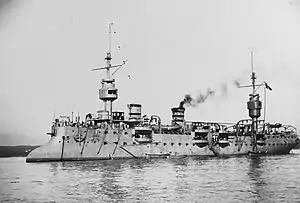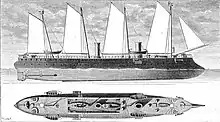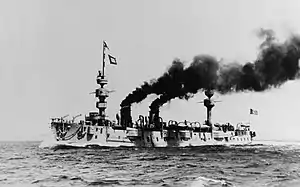Alger-class cruiser
The Alger class comprised three protected cruisers of the French Navy built in the late 1880s and early 1890s; the three ships were Alger, Isly, and Jean Bart. They were ordered as part of a fleet program that accorded with the theories of the Jeune École, which proposed a fleet based on cruisers and torpedo boats to defend France. The Alger-class cruisers were intended to serve a long-range commerce raiders to attack enemy merchant shipping. The ships were armed with a main battery of four 164 mm (6.5 in) guns supported by six 138 mm (5.4 in) guns and they had a top speed of 19 to 19.5 knots (35.2 to 36.1 km/h; 21.9 to 22.4 mph).
 Alger | |
| Class overview | |
|---|---|
| Name: | Alger class |
| Builders: | |
| Operators: |
|
| Preceded by: | Troude class |
| Succeeded by: | Friant class |
| Built: | 1887–1893 |
| In commission: | 1891–1914 |
| Completed: | 3 |
| Lost: | 1 |
| Retired: | 2 |
| General characteristics | |
| Class and type: | Protected cruiser |
| Displacement: | 4,313 long tons (4,382 t) |
| Length: | 105 m (344 ft 6 in) pp |
| Beam: | 12.98 m (42 ft 7 in) |
| Draft: | 6.10 to 6.45 m (20 ft 0 in to 21 ft 2 in) |
| Installed power: |
|
| Propulsion: | |
| Speed: | 19 to 19.5 knots (35.2 to 36.1 km/h; 21.9 to 22.4 mph) |
| Range: | 3,200 nmi (5,900 km; 3,700 mi) at 10 knots (19 km/h; 12 mph) |
| Complement: | 387–405 |
| Armament: |
|
| Armor: |
|
After entering service, Alger and Isly were assigned to the Northern Squadron, while Jean Bart operated with the Mediterranean Squadron until 1895, when she, too, joined the Northern Squadron. That year, Alger and Isly were sent to French Indochina, and they were followed by Jean Bart followed in 1898. By that time, Alger had returned to France to serve in the Mediterranean. Jean Bart was present in the Far East during the Boxer Uprising in Qing China the following year, by which time Isly had been transferred to the North Atlantic station. Alger embarked on a second tour in East Asia in the mid-1900s, though records of when she left France are unclear. Jean Bart was wrecked off the coast of the Western Sahara in 1907 and could not be refloated. Isly was converted into a depot ship in 1909 and Alger was hulked in 1911; the former was sold to ship breakers in 1914, but Alger remained in the French Navy's inventory until 1939.
Design
By 1886, Admiral Théophile Aube had become the French Minister of Marine. Aube was an ardent supporter of the Jeune École doctrine, which envisioned using a combination of cruisers and torpedo boats to defend France and attack enemy merchant shipping. By the time Aube had come to office, the French Navy had laid down three large protected cruisers that were intended to serve as commerce raiders: Sfax, Tage, and Amiral Cécille. His proposed budget called for another six large cruisers and ten smaller vessels, but by the time it was approved later in 1886, it had been modified to three large cruisers, two medium cruisers, and six small cruisers. The three Algers filled the requirement for the large vessels,[1][2] and they proved to be the last of the large commerce-raiding cruisers built for the French fleet ordered by Aube.[3] The French Navy would later return to the idea with Guichen and Châteaurenault in the late 1890s.[4]
General characteristics and machinery

The ships of the Alger class were 105 m (344 ft 6 in) long between perpendiculars and 105.5 m (346 ft) long at the waterline, with a beam of 12.98 m (42 ft 7 in) and a draft of 6.10 to 6.45 m (20 ft 0 in to 21 ft 2 in). They displaced 4,313 long tons (4,382 t). Their hulls featured a pronounced ram bow and a tumblehome shape, along with a sloped, overhanging stern. The ships had a minimal superstructure, consisting primarily of a small conning tower and bridge forward. Their crew varied over the course of their careers, amounting to 387–405 officers and enlisted men.[3][5]
Reports of the ships' rigging are mixed; according to Conway's All the World's Fighting Ships, the cruisers carried a pair of heavy military masts fitted with fighting tops for some of their light guns and observation positions. But in an article in Warship International quoting the 1905 edition of the Marine Almanac, Fisher states that the vessels were originally barque rigged, the sails being removed by the mid-1890s.[3][5] An 1893 article in the Scientific American Supplement, using an illustration from the French newspaper L'Illustration, depicts Alger with military masts.[6]
The ship's propulsion system consisted of a pair of vertical triple-expansion steam engines for Alger and horizontal triple-expansion engines for Jean Bart and Isly, driving two screw propellers in all three vessels. Steam was provided by twenty-four coal-burning Belleville type water-tube boilers for Alger, while Jean Bart and Isly received eight of the older fire-tube boilers. Each ships' boilers were ducted into two funnels. Their machinery was rated to produce 8,000 indicated horsepower (6,000 kW) for a top speed of 19 to 19.5 knots (35.2 to 36.1 km/h; 21.9 to 22.4 mph). Normal coal storage amounted to 860 long tons (870 t), but up to 940 long tons (960 t) could be carried. This permitted a cruising radius of 3,200 nautical miles (5,900 km; 3,700 mi) at 10 knots (19 km/h; 12 mph) with the normal load, and 4,000 nmi (7,400 km; 4,600 mi) at the same speed with the maximum.[3][5]
Armament and armor

The ships were armed with a main battery of four 164 mm (6.5 in) 28-caliber guns and six 138 mm (5.4 in) 30-cal. guns. All of these guns were placed in individual pivot mounts on the upper deck; the 164 mm guns were in sponsons located fore and aft, with two guns per broadside. Four of the 138 mm guns were in sponsons between the 164 mm guns, one was in an embrasure in the forecastle and the last was in a swivel mount on the stern.[5] The 138 mm guns were supplied with a variety of shells, including solid cast iron projectiles and explosive armor-piercing shells, both of which weighed 30 kg (66 lb). The guns fired with a muzzle velocity of 590 m/s (1,900 ft/s).[7]
For close-range defense against torpedo boats, they carried a pair of 65 mm (2.6 in) 9-pounder guns, eight 47 mm (1.9 in) 3-pounder Hotchkiss guns, and eight 37 mm (1.5 in) Hotchkiss revolver cannon. They were also armed with five 350 mm (14 in) torpedo tubes in their hull above the waterline.[5]
Armor protection consisted of a curved armor deck that was 50 mm (2 in) thick on the flat portion, increasing in thickness to 100 mm (4 in) on the sides, where it curved down to meet the sides of the hull. Above the deck, the ships had a 0.79 m (2 ft 7 in) wide cofferdam that was extensively compartmentalized to control flooding in the event of damage above the deck. The ships had 50 to 75 mm (2 to 3 in) plating on the conning tower. Isly and Jean Bart received gun shields that were 50 mm thick; these were fitted to the 164 and 138 mm guns.[5]
Construction
| Name | Laid down[5] | Launched[5][8] | Completed[5] | Shipyard[5] |
|---|---|---|---|---|
| Alger | November 1887 | 23 November 1889 | 1891 | Arsenal de Cherbourg, Cherbourg |
| Isly | August 1887 | 23 June 1891 | 1893 | Arsenal de Brest, Brest |
| Jean Bart | September 1887 | November 1889 | 1891 | Arsenal de Rochefort, Rochefort |
Service history

Alger served with the Northern Squadron early in her career, where she took part in routine peacetime training exercises. Isly joined her there as part of the Reserve Division, being activated only for maneuvers with the unit.[9][10] Jean Bart, meanwhile, initially served with the Mediterranean Squadron before being transferred to the Northern Squadron in 1895.[9][11] That year, Alger and Isly were deployed to French Indochina;[12] the latter briefly returned to France the following year before embarking on another deployment to the Far East in 1897 to relieve Alger.[13] After returning home, Alger served with the Mediterranean Squadron while Jean Bart was modernized and had her heavy military masts removed.[14][15]
Jean Bart joined Isly in Indochina in 1898, though the latter was reassigned to the North Atlantic station in 1899. Jean Bart was part of the French fleet that responded to the Boxer Uprising in Qing China later that year.[16] Alger had been reduced to reserve by 1901,[18] and in May that year, Jean Bart was recalled home, where she was also placed in reserve.[19] In 1902, Isly had new water-tube boilers installed.[20] Jean Bart was similarly modified between 1903 and 1906.[5] Reports conflict over Alger's activities in the mid-1900s; contemporary reports place her in the Mediterranean for fleet maneuvers,[21] but later historians state the ship was on a second tour in East Asia from 1905. Both agree that Alger served in Asian waters as late as 1908.[22]
In the meantime, Jean Bart had run aground off the Western Sahara in early 1907 and could not be refloated.[5] In 1908, Isly was briefly sent to French Morocco, and the following year she was converted into a depot ship for destroyers.[3] Alger was similarly reduced to a storage hulk in 1911, while Isly was struck from the naval register in 1914 and thereafter broken up. Alger survived in the fleet's inventory until 1939, when she, too, was sold to ship breakers.[8]
Notes
- Gardiner, pp. 308–310.
- Ropp, pp. 158–159, 172.
- Fisher, p. 238.
- Ropp, p. 284.
- Gardiner, p. 310.
- The New Cruiser Alger, p. 14669.
- Friedman, p. 223.
- Gardiner & Gray, p. 193.
- Brassey 1893, p. 70.
- Barry, pp. 201–208, 213.
- Brassey 1895, p. 50.
- Brassey 1895, p. 54.
- Brassey 1897, p. 62.
- Thursfield, pp. 138–140.
- Garbett 1897, p. 341.
- Brassey 1898, pp. 59–60.
- Jordan & Caresse 2017, p. 219.
- Garbett 1901, p. 611.
- Garbett 1903, p. 86.
- Leyland, pp. 102–106.
- Jordan & Caresse 2019, p. 57.
References
| Wikimedia Commons has media related to Alger class cruisers. |
- Barry, E. B. (1895). "The Naval Manoeuvres of 1894". The United Service: A Monthly Review of Military and Naval Affairs. Philadelphia: L. R. Hamersly & Co. XII: 177–213. OCLC 228667393.
- Brassey, Thomas A. (1893). "Chapter IV: Relative Strength". The Naval Annual. Portsmouth: J. Griffin & Co.: 66–73. OCLC 496786828.
- Brassey, Thomas A. (1895). "Chapter III: Relative Strength". The Naval Annual. Portsmouth: J. Griffin & Co.: 49–59. OCLC 496786828.
- Brassey, Thomas A. (1897). "Chapter III: Relative Strength". The Naval Annual. Portsmouth: J. Griffin & Co.: 56–77. OCLC 496786828.
- Brassey, Thomas A. (1898). "Chapter III: Relative Strength". The Naval Annual. Portsmouth: J. Griffin & Co.: 56–66. OCLC 496786828.
- Fisher, Edward C., ed. (1969). "157/67 French Protected Cruiser Isly". Warship International. Toledo: International Naval Research Organization. VI (3): 238. ISSN 0043-0374.
- Friedman, Norman (2011). Naval Weapons of World War One: Guns, Torpedoes, Mines and ASW Weapons of All Nations; An Illustrated Directory. Annapolis: Naval Institute Press. ISBN 978-1-84832-100-7.
- Garbett, H., ed. (March 1897). "Naval Notes: France". Journal of the Royal United Service Institution. London: J. J. Keliher & Co. XLI (229): 341–348. OCLC 1077860366.
- Garbett, H., ed. (May 1901). "Naval Notes: France". Journal of the Royal United Service Institution. London: J. J. Keliher & Co. XVI (279): 610–614. OCLC 1077860366.
- Garbett, H., ed. (1903). "Naval Notes: France". Journal of the Royal United Service Institution. London: J. J. Keliher & Co. XLVII (299): 84–89. OCLC 1077860366.
- Gardiner, Robert, ed. (1979). Conway's All the World's Fighting Ships 1860–1905. London: Conway Maritime Press. ISBN 978-0-85177-133-5.
- Gardiner, Robert & Gray, Randal, eds. (1985). Conway's All the World's Fighting Ships: 1906–1921. Annapolis: Naval Institute Press. ISBN 978-0-87021-907-8.
- Jordan, John & Caresse, Philippe (2017). French Battleships of World War One. Annapolis: Naval Institute Press. ISBN 978-1-59114-639-1.
- Jordan, John & Caresse, Philippe (2019). French Armoured Cruisers 1887–1932. Barnsley: Seaforth Publishing. ISBN 978-1-5267-4118-9.
- Leyland, John (1907). Brassey, Thomas A. (ed.). "Chapter IV: The French and Italian Manoeuvres". The Naval Annual. Portsmouth: J. Griffin & Co.: 102–111. OCLC 496786828.
- "Naval Notes: France". Journal of the Royal United Service Institution. London: J. J. Keliher & Co. XLIII (254): 322–324. April 1899. OCLC 1077860366.
- Ropp, Theodore (1987). Roberts, Stephen S. (ed.). The Development of a Modern Navy: French Naval Policy, 1871–1904. Annapolis: Naval Institute Press. ISBN 978-0-87021-141-6.
- "The New Cruiser Alger". Scientific American Supplement. New York: Munn & Co. XXXVI (918). 5 August 1893. OCLC 247178044.
- Thursfield, J. R. (1898). Brassey, Thomas A. (ed.). "II: French Naval Manoeuvres". The Naval Annual. Portsmouth: J. Griffin & Co.: 138–143. OCLC 496786828.
